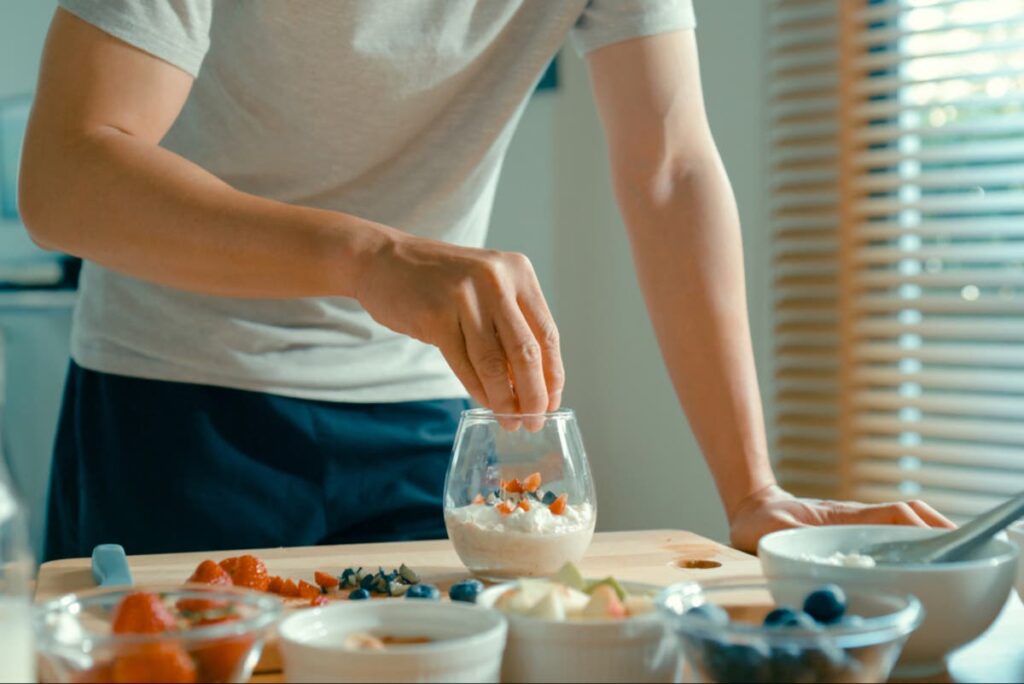Is yoghurt in the morning as healthy as you think? These are the warning signs

Your support helps us to tell the story
This election is still a dead heat, according to most polls. In a fight with such wafer-thin margins, we need reporters on the ground talking to the people Trump and Harris are courting. Your support allows us to keep sending journalists to the story.
The Independent is trusted by 27 million Americans from across the entire political spectrum every month. Unlike many other quality news outlets, we choose not to lock you out of our reporting and analysis with paywalls. But quality journalism must still be paid for.
Help us keep bring these critical stories to light. Your support makes all the difference.
A trip down the dairy aisle to grab a carton of yoghurt used to be a relatively straightforward affair. Now, though, the chilled section of the supermarket is home to a frankly overwhelming array of options. Yes, the humble natural yoghurt is still there, but it sits alongside fat-free versions, protein-heavy pots promising gym gains, fancy-looking offerings flavoured with salted caramel or adventurous fruits, and squashy pouches for kids. Then there are the dairy-free alternatives, products shouting about their Greek or Icelandic heritage – and whatever the heck kefir is.
Just as confusing to navigate is the mixed messaging that has sprung up around this particular food family. Is yoghurt a superfood? Or more like a super sweet dessert, deceptively dressed up as a healthy snack? Are low-fat options really as good for us as adverts featuring joyful, yoghurt-eating female celebs would have us believe? Or are the low-cal options packed with nasty chemicals best avoided? And what’s the difference between “Greek” and “Greek-style”? It can be difficult to unpick the genuine claims from the marketing spin.
It’s somewhat ironic, considering that yoghurt, in its original form, is actually pretty straightforward. It can be made from just two ingredients: milk and live bacteria. Adding the bacterial culture to milk kicks off the fermentation process, as the naturally occurring sugar lactose is converted into lactic acid. This thickens the milk to a creamier consistency, and gives it that slightly tangy taste. Greek yoghurt has an even thicker texture, thanks to a slightly different process: the yoghurt is traditionally drained through mesh cloth to get rid of some of the liquidy whey. It has less lactose, and therefore contains less sugar and fewer carbohydrates, and higher protein levels (hence why you’ve probably seen it crop up again and again in those “What I eat in a day” videos on social media).
Natural yoghurt does have plenty of health benefits. “It is a rich source of the mineral calcium, which is important to support healthy bones and teeth,” explains Reema Pillai, a private IBS dietitian. Plus it “provides B vitamins, including B12, which plays a key role in DNA synthesis and nerve function”. The fermentation process makes nutrients easier to digest and absorb, too. And now that gut health seems to be at the top of the wellbeing agenda, yoghurt is a relatively simple way to pack good bacteria into your diet (if, say, you’re yet to acquire a taste for sipping on kombucha).
“We have trillions and trillions of bacteria in our gut,” says Dr Zia Stratos, registered associate nutritionist at The Galen Clinic in London. “Many of these are good for us – they aid in digestion, produce and regulate hormones, and are key for our mental and physical health.” The probiotics (another term for live bacteria with beneficial properties) that exist in yoghurt, she adds, “increase the ‘good’ bacteria in our gut. This contributes to a balanced and diverse microbiome, which is associated with reduced inflammation and lower risk of chronic illness”.

All of which sounds great, right? But not all yoghurts are created equal. For a start, not all of them have enough live or active cultures to make a real difference, according to nutritionist GQ Jordan. She recommends taking a look at the ingredients section, “where it will say the specific strains that it contains, usually lactobacillus acidophilus or bifidobacterium”. And then there’s the fact that many flavoured varieties – even if they’re something healthy-sounding like fruit, rather than being chocolatey and laden with tiny biscuits and sprinkles – “can contain high levels of added sugars”, Pillai says.
There are over 100 different names for sugar used on ingredient labels
Dr Zia Stratos
In 2018, a study from researchers at Surrey and Leeds Universities found that some supermarket yoghurts contained more sugar than Coca-Cola; brands aimed at children and organic offerings were among the worst offenders, with total average sugars of 10.8g per 100g and 13.1g per 100g respectively. The latter stat might seem particularly surprising: a phenomenon known as the “health halo” effect can cause shoppers to mistakenly believe that “good” products like organic ranges are better for us than they actually are. Sugar does naturally occur in yoghurt, but, Pillai notes, “this is usually at a content of 3g per 100g”. Things are getting a bit better, but only slowly. Yoghurts did end up achieving one of the largest reductions (13.5 per cent) in sugars between 2015 and 2020 as part of the government’s sugar reduction programme, but this was considerably shy of the 20 per cent target.
Food manufacturers, Dr Stratos says, are very savvy when it comes to disguising sugar on an ingredients list. “There are over 100 different names for sugar used on ingredient labels,” she explains. Anything ending with “ose” indicates a sugar, and terms like “syrup”, “concentrate” and “fruit juice” frequently crop up too, as do artificial sweeteners. These “provide the sweet flavour without using sugar”, Pillai says, but they’re not necessarily a get-out-of-jail-free card for those of us with a sweet tooth: “We are unsure of the long-term health consequences of high sweetener consumption.” Dr Stratos adds that, though sugar substitutes such as sucralose may be zero calories, since we don’t digest them “they stick around in our intestines and feed the ‘bad’ gut bacteria that negatively alter the microbiome and fuel inflammation”.

When it comes to our diets, many of us have been drilled to see fat as the enemy, and “fat free” products as our saviours. But fat, Dr Stratos says, “is a really important component of flavour, and dairy products often don’t taste as good without it”. These products tend to compensate by ramping up, you guessed it, the sugar and sweeteners. “If it’s low fat, it’s going to be high in sugar, and that’s not good for our blood sugar balance and it’s not good for our gut health,” says Jordan. “If you have a fat-free yoghurt at breakfast time, you’re likely to feel more hungry mid-morning; if you’d had the full fat, it might have helped you to go through until lunchtime.” For this reason, she’d always recommend “going for either a 2 per cent or 5 per cent Greek yoghurt” – not, take note, Greek style, which often uses artificial thickeners or corn starch to mimic the real deal’s texture – from a brand like Fage, which is tough to pronounce but “avoids those more dubious ingredients”.
In other words, your apparently “healthy” choice might actually be totally self-defeating. If you’re after a fruit flavour, “it’s better to just add the fruit in”, Jordan says, “because you’re going to get more fibre that way, you’re going to get more antioxidants that way”. So when you’re scrutinising the ingredients list on a carton, think along the lines of: the fewer the better. And if you see more than three ingredients or any ingredients you can’t pronounce (aside from the bacterial cultures, of course, whose names are admittedly a bit of a mouthful) “or that you wouldn’t find in your grandmother’s pantry” as Dr Stratos puts it? You might be better off leaving it in the chilled aisle.
is-yoghurt-in-the-morning-as-healthy-as-you-think-these-are-the-warning-signs





